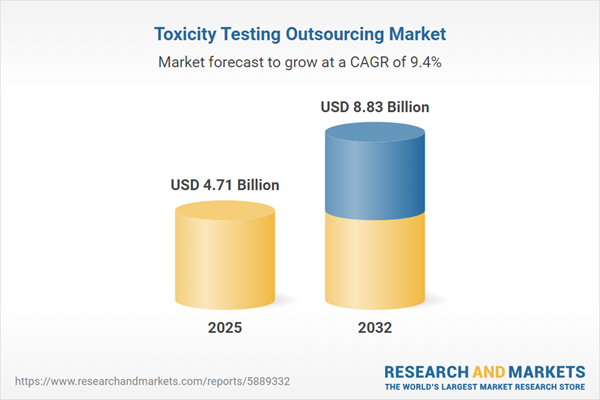Speak directly to the analyst to clarify any post sales queries you may have.
Senior executives are increasingly leveraging toxicity testing outsourcing to manage evolving regulatory standards and operational demands. As requirements intensify across global markets, strategic partnerships with specialized laboratories are driving greater agility, risk management, and regulatory confidence.
Toxicity Testing Outsourcing Market Snapshot
The toxicity testing outsourcing market continues to expand, underscored by a robust compound annual growth rate (CAGR) and a marked increase in market value. Demand for more effective safety protocols and heightened regulatory oversight is reshaping industry requirements. Critical sectors—including pharmaceuticals, chemicals, and consumer products—are adopting more rigorous and responsive outsourcing models. Service providers equipped with advanced infrastructure and sophisticated compliance processes enable clients to better manage both risk and evolving regulatory requirements. This shift positions well-selected partners as essential to regulatory alignment and operational flexibility in today’s interconnected business environment.
Scope & Segmentation of the Toxicity Testing Outsourcing Market
- Service Providers: Academic laboratories drive early-phase experimentation and methodological advancement, while contract research organizations offer comprehensive oversight, deep regulatory acumen, and adaptable compliance support for multinational portfolios.
- End Users: Agrochemical firms ensure crop safety and responsible pest management; biotechnology organizations advance research breakthroughs; chemical manufacturers depend on precise toxicity profiling; cosmetics companies prioritize ingredient transparency; food and beverage producers address dynamic safety standards; pharmaceutical organizations seek full life cycle testing to maintain industry compliance.
- Test Model Types: In silico approaches—including physiologically based pharmacokinetic (PBPK) and quantitative structure-activity relationship (QSAR) models—offer computationally driven predictive toxicology. In vitro platforms deliver cellular-level analysis, and in vivo studies meet approval criteria within established ethical standards.
- Geographies: The Americas, EMEA, and Asia-Pacific regions each encounter unique regulatory challenges and adoption speeds for new technologies. Providers operating internationally require specialized local expertise and adaptable compliance strategies to serve these varying markets.
- Leading Companies: Charles River Laboratories International, Laboratory Corporation of America Holdings, Eurofins Scientific, WuXi AppTec, ICON, SGS SA, PAREXEL International, Syngene International, Inotiv, and Evotec SE supply broad technical capabilities and deep market specialization.
Key Takeaways for Decision-Makers
- Partnerships with both academic and contract research specialists broaden scientific capability and simplify the path to regulatory adherence.
- Adoption of AI and advanced analytical technologies within laboratory environments accelerates analysis and enhances project-level decision-making.
- Ongoing innovation in toxicity testing methodologies helps organizations remain aligned with evolving global safety and regulatory demands.
- Expansion of laboratory capacity in strategically selected regions mitigates risks tied to regulatory shifts and supply chain disruption.
- Integration efforts through mergers and acquisitions facilitate rapid adaptation to new operational demands and evolving compliance environments.
- Developing localized partnerships offers organizations flexibility to tailor regulatory compliance strategies to region-specific requirements.
Tariff Impact on Operational Viability
Recent changes in United States tariffs have led to increased costs for laboratory reagents and consumables, presenting new challenges for toxicity testing firms. Organizations are adapting by diversifying supplier portfolios, increasing dependence on local vendors, and expanding use of in silico and in vitro techniques. These measures maintain performance and compliance standards as cost structures and sourcing conditions evolve.
Research Methodology & Data Sources
This analysis is built upon insights from senior industry executives, laboratory managers, and regulatory professionals. Data are drawn from peer-reviewed literature, industry association reports, and official regulatory guidance to ensure actionable and relevant findings.
Why This Report Matters
- Provides actionable guidance for leaders navigating the complexities of toxicity testing outsourcing and shifting regulatory requirements.
- Outlines clear segmentation to inform partnership strategies and promote regulatory adherence.
- Equips organizations with the operational and compliance knowledge needed as global standards and testing technologies evolve.
Conclusion
This report supports decision-makers with targeted market insights and strategic context, positioning organizations to proactively respond to regulatory change and maintain operational resilience in toxicity testing outsourcing.
Additional Product Information:
- Purchase of this report includes 1 year online access with quarterly updates.
- This report can be updated on request. Please contact our Customer Experience team using the Ask a Question widget on our website.
Table of Contents
3. Executive Summary
4. Market Overview
7. Cumulative Impact of Artificial Intelligence 2025
Companies Mentioned
The companies profiled in this Toxicity Testing Outsourcing market report include:- Charles River Laboratories International, Inc.
- Laboratory Corporation of America Holdings
- Eurofins Scientific SE
- WuXi AppTec Co., Ltd.
- ICON PLC
- SGS SA
- PAREXEL International Corporation
- Syngene International Limited
- Inotiv, Inc.
- Evotec SE
Table Information
| Report Attribute | Details |
|---|---|
| No. of Pages | 187 |
| Published | November 2025 |
| Forecast Period | 2025 - 2032 |
| Estimated Market Value ( USD | $ 4.71 Billion |
| Forecasted Market Value ( USD | $ 8.83 Billion |
| Compound Annual Growth Rate | 9.3% |
| Regions Covered | Global |
| No. of Companies Mentioned | 11 |









